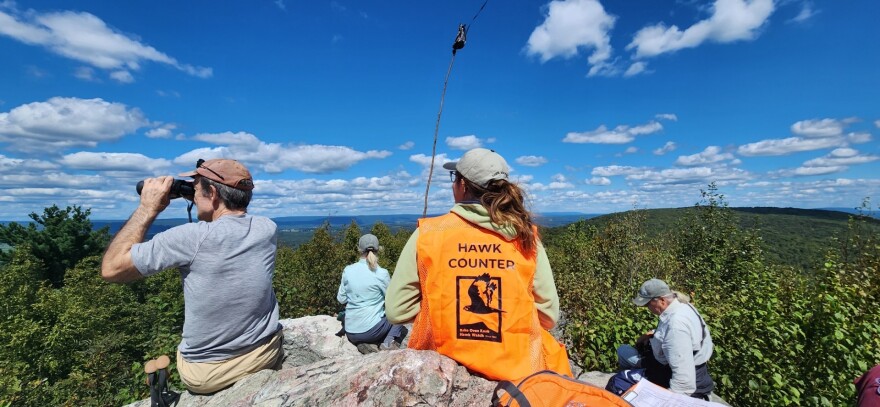HEIDELBERG TWP., Pa. — The lack of rain in the Lehigh Valley’s forecast over the past few months proved to be both good and bad for an annual autumn hawk count.
“We had more days on the mountain – we had volunteers and interns up there more often,” said Chad Schwartz, executive director of the Lehigh Gap Nature Center. “But the cold fronts that come along with the rain usually generate winds that help the birds come through.
“We typically, in a year like this where it's really calm, we'd expect fewer birds. But overall, for most species, that's not what we saw.”
Lehigh Gap Nature Center’s annual autumn Bake Oven Knob Hawk Watch ended late last month, with 9,373 migrating raptors recorded. While the overall count is lower than last year, which saw just shy of 11,000, Schwartz said many species exceeded 2023 totals.
“We saw numbers that were either close to average or, in some cases, above average this year."Chad Schwartz, executive director of the Lehigh Gap Nature Center
“We saw numbers that were either close to average or, in some cases, above average this year,” Schwartz said. “The weather, or the lack of weather, didn't really have as much of a negative impact as we might expect.”
While there were less broad-winged hawks than usual, attributed to the weather, it was the second-highest bald eagle count, with 437 recorded. The Cooper’s hawk and merlin totals — 346 and 104, respectively — were within the top 10 highest counts for each species.
While still below long-term averages, osprey, northern harrier, sharp-shinned hawk and red-shouldered hawk totals were above their respective five-year averages.

‘You can learn a lot’
In its 64th year, the hawk watch is run by officials, with the help of many volunteers, who count birds of prey as they migrate along the raptor "superhighway" in the Lehigh Valley’s backyard.
Observers are tasked with spotting birds as they fly past the lookout, while counters record and report bird migration data.
Counting and recording migrating populations is an important part of conservation research. Raptors have been decimated by both their state-approved slaughter in the 1960s — they were viewed as a threat to poultry and other game animals — as well as continued habitat loss.
“You can learn a lot by seeing how the migration numbers change from year to year,” Schwartz said. “In the case of birds like the bald eagle, years ago, that decline that we saw at hawk watches was indicative of population decline that had to be addressed.
“So the fact that DDT is banned in the United States now is the result of monitoring these bird populations over time. That's how we knew something was wrong and we were able to do something about it.”
DDT, or dichloro-diphenyl-trichloroethane, was developed in the 1940s as the first modern synthetic insecticide, according to the Environmental Protection Agency. However, it was banned in 1972 after its use was linked to a decline of bald eagle and other bird-of-prey populations.
“More generally, it helps us understand even not necessarily population declines, but shifts in behavior due to climate change, and things like that,” he said. “It's not just about the health of the population, but also just behavioral shifts. We just understand these birds a bit better.”
Data from the watch is fed to HawkCount, run by the Hawk Migration Association of North America.
“It is an international organization, so they maintain the records from dozens of hawk watch sites across Canada, United States and Mexico,” Schwartz said. “And then scientists around the world will use the data from that organization to conduct different types of studies.
“The information that we report, it's great for us to have to maintain these records, but it's also useful for scientists who are studying things over a broader scale.”
A new sponsor
This year’s hawk watch ran from Aug. 15 through Nov. 29. While it’s a decades-old effort, there were some changes this season.
For the first time, the count was sponsored by the Pennsylvania Game Commission.
“The biggest thing that we're able to do is hire a weekend hawk watcher,” Schwartz said. “He was up there just about every weekend throughout the season, helping with the count, but also educating visitors up on the mountain.
“He had information that he would share about the migration, but he also led some guided hikes up there to get people out to the site.”

More than 2,600 visitors passed through the hawk watch, he said. James Holt, the weekend hawk watcher, taught 615 of those visitors about migration.
“We had 100% coverage at the hawk count this year because of that too,” Schwartz said. “Some years, it's tough to get volunteers up on the mountain. But, this year, between hiring a weekend hawk watcher, and also recruiting new volunteers, we had 100% coverage for the whole season."
In addition, the sponsorship allowed the center to outfit volunteers with new kits, as well as purchase some binoculars for school programs. New signs were added, too.
“They did some maintenance on the site,” Schwartz said. “They cut down some of the vegetation that was blocking community view. So, they've been really helping us, not just with the funding that they provided, but managing the site too."


